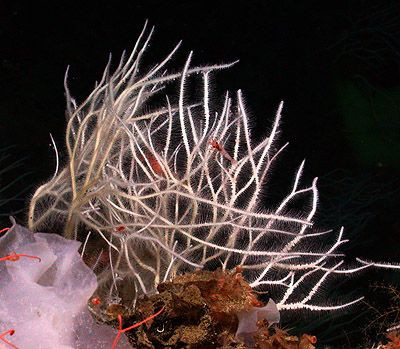‘Killer’ Sea Sponges: Four New Species Of Carnivorous Sponges Discovered In Deep Seas Of North Pacific

Not only are sea sponges thought to have played a key role in the evolution of life on Earth, they’re also cold-hearted killing machines. Well, at least some of them are. Researchers have discovered four new species of carnivorous sponges lurking in the deep waters of the North Pacific.
According to a new study published in the current issue of ZooTaxa, the ocean off the west coasts of the U.S. and Canada is home to several species of “killer” sea sponges that look more like small shrubs or spiny noodles than your typical “loofas.”
Most sponges are filter feeders, living off of tiny bacteria and single-celled organisms that they ingest by sifting the water around them. The new species of carnivorous sponges, however, like to dine on small crustaceans, particularly shrimp-like amphipods and copepods.
Researchers from the Monterey Bay Aquarium Research Institute in California describe how the new species of sponges use the tiny hairs that cover their bodies to hook small animals. Once an animal like a shrimp is trapped, the sponge begins to digest it. According to researchers, it takes just a few hours for the sponges’ cells to begin the process of absorbing its prey.
All that's left of the meal after several days is an empty shell.
Scientists first discovered carnivorous sea sponges species about 20 years ago. A 1995 study published in the journal Nature described 24 strange new species of sponges, including one that looks like a bunch of ping-pong balls stuck together. Several of the sponges described in that study were carnivorous.
The identification of four new “killer” sponge species brings the total number of known carnivorous sea sponges in the North Pacific region to 11. Across the globe, scientists have identified 137 species of animal-eating sponges.
“Typical sponges must continually beat the flagella of choanocytes to create a current, which flows through their bodies. From this current they strain single celled organisms and bacteria, which they eat,” Lonny Lundsten, a marine biologist from Monterey Bay Aquarium Research Institute, told CBC News. “But constantly beating these flagella is not efficient, energetically, when food is largely unavailable. Rather than creating a current, carnivores act more like spiders' webs, with a matrix of tiny hooks waiting to catch any plankton that drift past them in the currents.”
The ocean is home to about 8,500 species of sponges. They vary in size, shape and depth, and are mostly stationary.
Carnivorous sponges typically live in very deep waters ranging from 600 to 3,400 meters offshore. That makes them incredibly hard to locate and study. To find them, scientists use remote-controlled vehicles with cameras mounted on top.
© Copyright IBTimes 2024. All rights reserved.






















